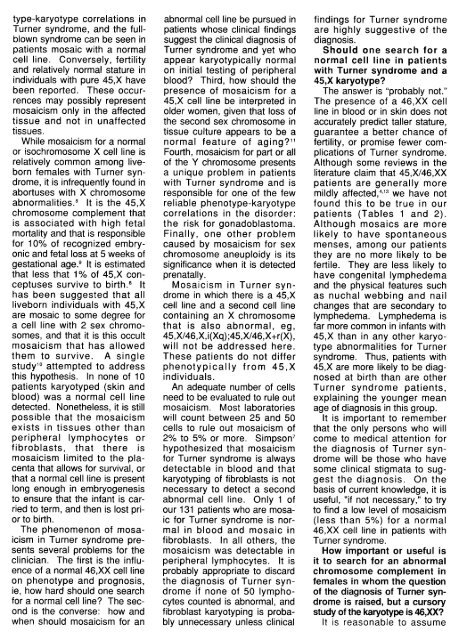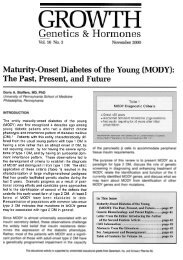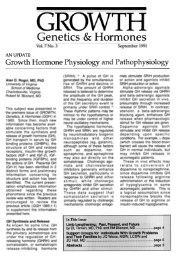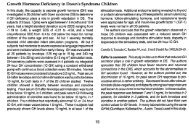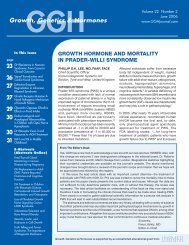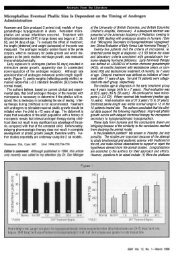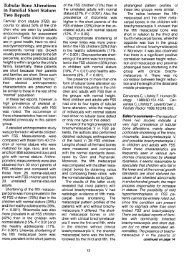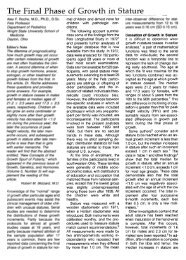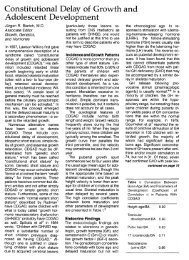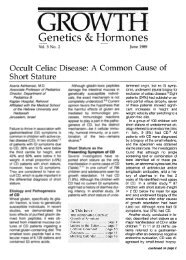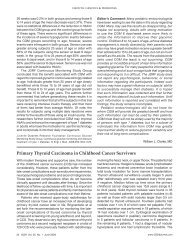Mosaicism in Turner Syndrome - GGH Journal
Mosaicism in Turner Syndrome - GGH Journal
Mosaicism in Turner Syndrome - GGH Journal
Create successful ePaper yourself
Turn your PDF publications into a flip-book with our unique Google optimized e-Paper software.
type-karyotype correlations <strong>in</strong> abnormal cell l<strong>in</strong>e be pursued <strong>in</strong><br />
<strong>Turner</strong> syndrome, and the fullblown<br />
patients whose cl<strong>in</strong>ical f<strong>in</strong>d<strong>in</strong>gs<br />
syndrome can be seen <strong>in</strong> suggest the cl<strong>in</strong>ical diagnosis of<br />
patients mosaic with a normal <strong>Turner</strong> syndrome and yet who<br />
cell l<strong>in</strong>e. Conversely, fertility appear karyotypically normal<br />
and relatively normal stature <strong>in</strong> on <strong>in</strong>itial test<strong>in</strong>g of peripheral<br />
<strong>in</strong>dividuals with pure 45,X have blood? Third, how should the<br />
been reported. These occurrences<br />
presence of mosaicism for a<br />
may possibly represent 45,X cell l<strong>in</strong>e be <strong>in</strong>terpreted <strong>in</strong><br />
mosaicism only <strong>in</strong> the affected older women, given that loss of<br />
tissue and not <strong>in</strong> unaffected the second sex chromosome <strong>in</strong><br />
tissues.<br />
tissue culture appears to be a<br />
While mosaicism for a normal normal feature of ag<strong>in</strong>g?11<br />
or isochromosome X cell l<strong>in</strong>e is Fourth, mosaicism for part or all<br />
relatively common among liveborn<br />
of the Y chromosome presents<br />
females with <strong>Turner</strong> syn-<br />
a unique problem <strong>in</strong> patients<br />
drome, it is <strong>in</strong>frequently found <strong>in</strong> with <strong>Turner</strong> syndrome and is<br />
abortuses with X chromosome responsible for one of the few<br />
abnormalities.8 It is the 45,X reliable phenotype-karyotype<br />
chromosome complement that correlations <strong>in</strong> the disorder:<br />
is associated with high fetal the risk for gonadoblastoma.<br />
mortality and that is responsible F<strong>in</strong>ally, one other problem<br />
for 10% of recognized embryonic<br />
caused by mosaicism for sex<br />
and fetal loss at 5 weeks of chromosome aneuploidy is its<br />
gestational age.9 It is estimated<br />
that less that 1 % of 45,X conceptuses<br />
significance when it is detected<br />
prenatally.<br />
survive to birth.8 It <strong>Mosaicism</strong> <strong>in</strong> <strong>Turner</strong> syn-<br />
has been suggested that all drome <strong>in</strong> which there is a 45,X<br />
liveborn <strong>in</strong>dividuals with 45,X cell l<strong>in</strong>e and a second cell l<strong>in</strong>e<br />
are mosaic to some degree for conta<strong>in</strong><strong>in</strong>g an X chromosome<br />
a cell l<strong>in</strong>e with 2 sex chromosomes,<br />
that is also abnormal, eg,<br />
and that it is this occult 45,X/46,X,i(Xq) ;45,X/46,X+r(X),<br />
mosaicism that has allowed will not be addressed here.<br />
them to survive. A s<strong>in</strong>gle These patients do not differ<br />
study1O attempted to address phenotypically from 45,X<br />
this hypothesis. In none of 10 <strong>in</strong>dividuals.<br />
patients karyotyped (sk<strong>in</strong> and An adequate number of cells<br />
blood) was a normal cell l<strong>in</strong>e need to be evaluated to rule out<br />
detected. Nonetheless, it is still mosaicism. Most laboratories<br />
possible that the mosaicism will count between 25 and 50<br />
exists <strong>in</strong> tissues other than cells to rule out mosaicism of<br />
peripheral lymphocytes or 2% to 5% or more. Simpson?<br />
fibroblasts, that there is hypothesized that mosaicism<br />
mosaicism limited to the placenta<br />
for <strong>Turner</strong> syndrome is always<br />
that allows for survival, or detectable <strong>in</strong> blood and that<br />
that a normal cell l<strong>in</strong>e is present karyotyp<strong>in</strong>g of fibroblasts is not<br />
long enough <strong>in</strong> embryogenesis necessary to detect a second<br />
to ensure that the <strong>in</strong>fant is carried<br />
abnormal cell l<strong>in</strong>e. Only 1 of<br />
to term, and then is lost pri-<br />
our 131 patients who are mosa-<br />
or to birth.<br />
ic for <strong>Turner</strong> syndrome is normal<br />
The phenomenon of mosaicism<br />
<strong>in</strong> blood and mosaic <strong>in</strong><br />
<strong>in</strong> <strong>Turner</strong> syndrome presents<br />
fibroblasts. In all others, the<br />
several problems for thecl<strong>in</strong>ician. mosaicism was detectable <strong>in</strong><br />
The first is the <strong>in</strong>fluence<br />
peripheral lymphocytes. It is<br />
of a normal 46,XX cell l<strong>in</strong>e probably appropriate to discard<br />
on phenotype and prognosis, the diagnosis of <strong>Turner</strong> syndrome<br />
ie, how hard should one search<br />
if none of 50 lympho-<br />
for a normal cell l<strong>in</strong>e? The second<br />
cytes counted is abnormal, and<br />
is the converse: how and fibroblast karyotyp<strong>in</strong>g is probacytes<br />
when should mosaicism for an bly unnecessary unless cl<strong>in</strong>ical<br />
f<strong>in</strong>d<strong>in</strong>gs for <strong>Turner</strong> syndrome<br />
are highly suggestive of the<br />
diagnosis.<br />
Should one search for a<br />
normal cell l<strong>in</strong>e <strong>in</strong> patients<br />
with <strong>Turner</strong> syndrome and a<br />
45,X karyotype?<br />
The answer is "probably not."<br />
The presence of a 46,XX cell<br />
l<strong>in</strong>e <strong>in</strong> blood or <strong>in</strong> sk<strong>in</strong> does not<br />
accurately predict taller stature,<br />
guarantee a better chance of<br />
fertility, or promise fewer complications<br />
of <strong>Turner</strong> syndrome.<br />
Although some reviews <strong>in</strong> the<br />
literature claim that 45,X/46,XX<br />
patients are generally more<br />
mildly affected,4.13 we have not<br />
found this to be true <strong>in</strong> our<br />
patients (Tables 1 and 2).<br />
Although mosaics are more<br />
likely to have spontaneous<br />
menses, among our patients<br />
they are no more likely to be<br />
fertile. They are less likely to<br />
have congenital lymphedema<br />
and the physical features such<br />
as nuchal webb<strong>in</strong>g and nail<br />
changes that are secondary to<br />
lymphedema. Lymphedema is<br />
far more common <strong>in</strong> <strong>in</strong>fants with<br />
45,X than <strong>in</strong> any other karyotype<br />
abnormalities for <strong>Turner</strong><br />
syndrome. Thus, patients with<br />
45,X are more likely to be diagnosed<br />
at birth than are other<br />
<strong>Turner</strong> syndrome patients,<br />
expla<strong>in</strong><strong>in</strong>g the younger mean<br />
age of diagnosis <strong>in</strong> this group.<br />
It is important to remember<br />
that the only persons who will<br />
come to medical attention for<br />
the diagnosis of <strong>Turner</strong> syndrome<br />
will be those who have<br />
some cl<strong>in</strong>ical stigmata to suggest<br />
the diagnosis. On the<br />
basis of current knowledge, it is<br />
useful, "if not necessary," to try<br />
to f<strong>in</strong>d a low level of mosaicism<br />
(less than 5%) for a normal<br />
46,XX cell l<strong>in</strong>e <strong>in</strong> patients with<br />
<strong>Turner</strong> syndrome.<br />
How important or useful is<br />
it to search for an abnormal<br />
chromosome complement <strong>in</strong><br />
females <strong>in</strong> whom the question<br />
of the diagnosis of <strong>Turner</strong> syndrome<br />
is raised, but a cursory<br />
study of the karyotype is 46,XX?<br />
It is reasonable to assume


